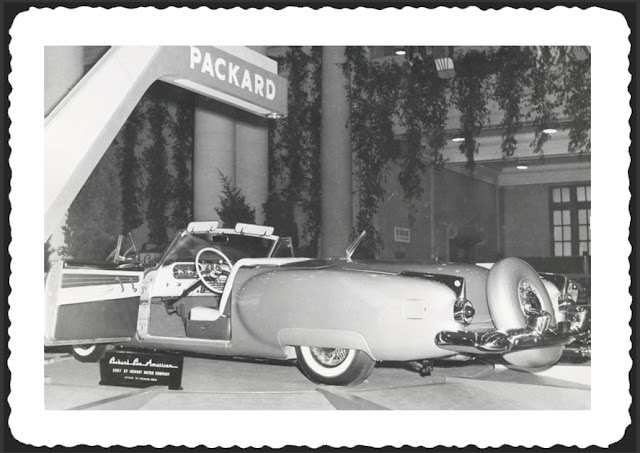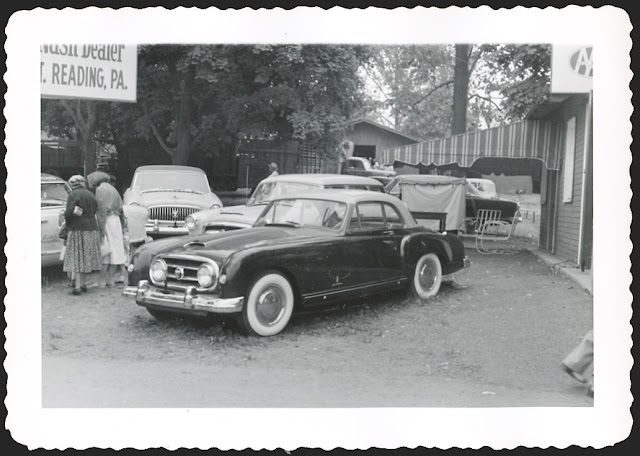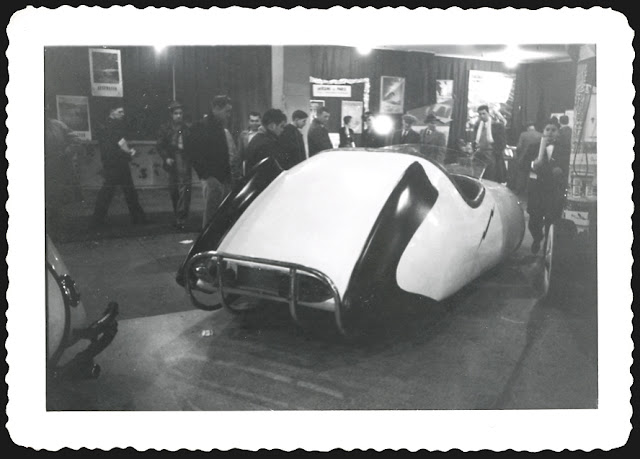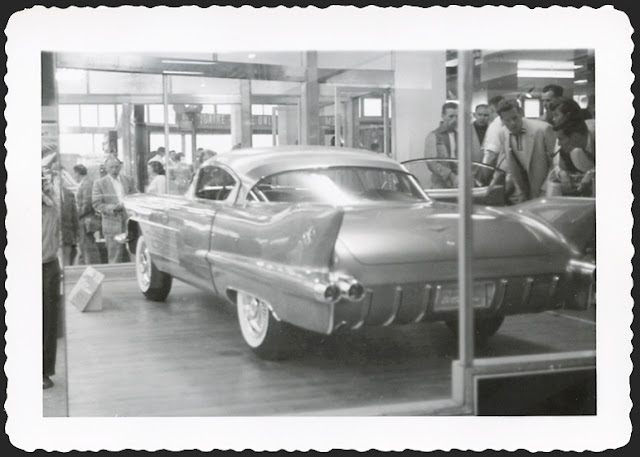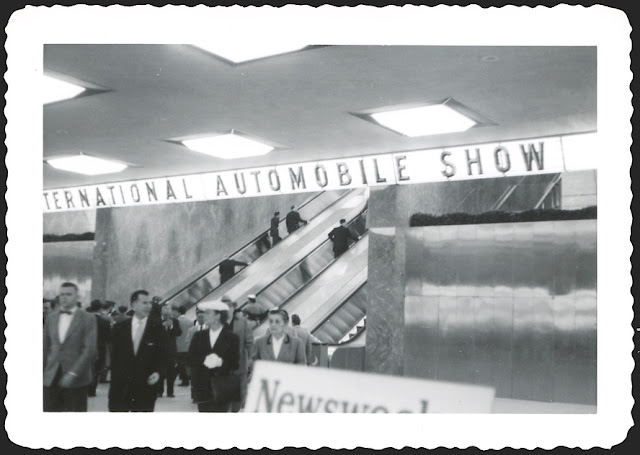Madison Square Garden, Eighth Avenue between 49th and 50th in Manhattan. Photos dated in pencil, this one 3/53. Kit Foster supplied official name and venue details for NYC auto shows of this era here, which was a great help. Fred Pittera's 1st World Motor Sports Show, Madison Square Garden, 2/53.
Circa 1950 Jetmobile built by Richard Harp of Boonesboro, Maryland, from an aircraft belly tank with wingtip pods on either side, powered by a rear-mounted Ford V8-60. Herb Shriner's First International Motor Sports Show, Grand Central Palace, 4/52.
Conceived by importer Max Hoffman, the Porsche America Roadster was intended as a lighter, faster, cheaper alternative to the standard 356 Cabriolet for the American market, with 1500 Super specs in an aluminum body by Glaser. Weekend racers could quickly lighten the car by 100lbs by removing hubcaps, jack and tools and replacing the street windscreen with perspex via two wing nuts and a single bolt. Unfortunately, each car took 640 hours to complete instead of the estimated 500 and the coachbuilder lost money on every one of the sixteen or so built, even at $4600 New York, declaring bankruptcy by the end of 1952. Which led Porsche to come up with its own version, the Speedster, introduced in 1954. Herb Shriner's First International Motor Sports Show, Grand Central Palace, 4/52.
'52 Siata 208 CS Scaglietti Barchetta Competizione by Bertone. This spider and the two-tone 208 CS 2+2 Berlinetta just behind were powered by 2 litre Fiat 8V (Otto Vu) engines in Siata's own purpose-built tubular chassis with modified Fiat running gear. Designer Franco Scaglietti, who started working with Nuccio Bertone in 1952, is credited with these two as well as all three Alfa Romeo B.A.T.s and the Arnolt Bristol. I haven't found official designations for either of these one-off Siatas, even in Luciana Greggio's Bertone 90 Years. Herb Shriner's First International Motor Sports Show, Grand Central Palace, 4/52.
One-off Cisitalia built by Ghia for Henry Ford II, powered by a 2.8 litre inline 4 marine-conversion engine developing 155hp. Cisitalia went under shortly thereafter. Herb Shriner's First International Motor Sports Show, Grand Central Palace, 4/52.
The 1952 Packard Pan American 'sports car' built for company president Hugh Ferry to a design by Richard Arbib, was a stock Packard 250 convertible reworked by hearse and ambulance specialist Henney. Venue and date unknown.
Chrysler Hemi powered 1952 Allard J2X, one of two envelope bodied cars built for an unsuccessful LeMans attempt. Fred Pittera's 1st World Motor Sports Show, Madison Square Garden, 2/53.
Fiat Zagato 1100 Panoramica. Fred Pittera's 1st World Motor Sports Show, Madison Square Garden, 2/53.
Adler Trumpf Rennlimousine. I don't believe this is one of the two cars with heart-shaped grilles that ran at LeMans in 1937 and 1938. AACA forum posts suggest that several cars were built, all slightly different. One is seen here fresh from a restoration by Joe Gertler's Raceway Garage in the Bronx. Fred Pitter's 1st World Motor Sports Show, Madison Square Garden, 2/53.
Fiat 1100 Castagna Sport Coupe. Oddball cantilever roof fantasy from a classic-era Italian coachbuilder on its very last legs. Wraparound front bumper seen in 1950 Fawcett digest Sports Cars and Hot Rods has gone missing. Venue and date unknown.
Ultra-exclusive exhibit of Brewster Automobiles, Oyster Bay, New York. Car in first picture looks like a 1951 Nash-Healey Panelcraft roadster with no hood scoop, the second shows Pegaso berlinettas and a Plexiglas-enhanced display chassis exposing quad overhead cam alloy V8 with desmodromic valves and dry sump lubrication, 5 speed transaxle, torsion bar suspension and deDion rear end with inboard brakes. Featured car is Pegaso Z102 called Tea Rose for its iridescent yellow paint that 'bloomed' as it grew paler from rocker panel to roof. Although two-thirds of the appoximately 86 cars Pegaso built between 1951 and 1958 were bodied by Touring and Saoutchik, two of these 'cupola' cars were apparently designed and built in-house by the state-owned Spanish truck and bus maker, attempting to invade the super luxury sports cars market with former Alfa Romeo engineer Wilfredo Ricart in charge. This particular $29,000 dream was bought off the stand by Generalissimo Rafael Trujillo of the Dominican Republic and widely known as El Dominicano thereafter. Fred Pittera's 1st World Motor Sports Show, Madison Square Garden, 2/53.
Glamorous 1953 Nash-Healey hardtop by Pininfarina amid humble brethren at a Pennsylvania farmers market new car show with live poultry and antiques. Cropped signage promotes Eckenroth Motors, Inc. at 22nd & Howard in Reading. 9/53.
The Flajole Forerunner was the creation of independent design consultant Bill Flajole, who was lucky enough to have a Nash-Kelvinator VP in attendance for a Detroit area civic group speech where he proposed a small, enconomical shopping car for the suburban housewife. Nash soon hired him to develop the NXI, which was received warmly enough at its 1950 Waldorf Astoria unveiling that Nash had Metropolitans in showrooms by March 1954. The Forerunner was a '53 Jaguar XK-120M under the startling fiberglass skin. Since this photo was taken in February 1954 and the car didn't make its official debut until September 1955, adorning the cover of Motor Trend with fender coves and retractable Plexiglas roof, I believe this is the design study, mounted on a '51 XK-120 frame according to Flajole's son Bill Jr. in the November 2010 issue of Octane. I distinctly remember its body propped up against the wall in Dad's studio while its chassis was being used as a frame for a wood and clay mock-up of the Forerunner body. Herb Shriner's Third Annual International Motor Sports Show, Seventh Regiment Armory, 2/54.
'25 Rolls Royce Phantom I by Jonckheere. As originally commissioned by Horace Dodge's widow Anna, the car was fitted with cabriolet coachwork by Hooper & Co. of London, coachbuilders to England's Royal Family and numerous crown heads of Europe. When Anna, one of the richest women in the universe at the time, grew bored, the car passed to the Raja of Nanpara and several others before turning up in Belgium in 1932. Extravagantly rebodied by Belgian coach and bus maker Jonckheere around 1934, it was awarded a Prix d'Honneur at the Cannes Concours d’Elegance in August 1936. From there it bounced downhill from owner to owner, eventually ending up in a New York area junkyard from which it was rescued and refurbished as a freak attraction, apocryphal claims attaching themselves like barnacles as the years passed. The monster is now finished in gleaming black and owned by the Petersen Museum. For more information, check out posts by David Greenlees at The Old Motor. Herb Shriner's Third Annual International Motor Sports Show, Seventh Regiment Armory, 2/54.
'54 Cadillac El Camino. Fiberglass body, brushed stainless steel roof, not a Chevy pickup. Venue and date unknown.
'55 Abarth Boano 207A Spider. Fiat 1100 mechanicals in a steel platform chassis with body designed by Giovanni Michelotti. Intended as a series production racer, the too-pretty-for-its-own-good 207A found itself easily outclassed by the featherweight Lotus Mk IX. As a result, only ten or so were built, most of them imported into the United States. Fred Pittera's Universal Travel and Auto Sports Show, Madison Square Garden, 2/55.
'53 Ferrari 250 Europa Coupé by Vignale. Enzo Ferrari's first luxury GT, built on a stretched 250MM chassis and powered by a 3 litre V12 Formula One engine designed by Aurelio Lampredi. The rich detailing of this Giovanni Michelotti design is better seen in recent color photosof this very car, scheduled for Bonhams Quail Lodge auction August 2013. Fred Pittera's Universal Travel and Auto Sports Show, Madison Square Garden, 2/55.
'55 BMW 502 V8 chassis, with barest glimpses of 502 'Baroque Angel' sedan and 507 roadster. Fred Pittera's Universal Travel and Auto Sports Show, Madison Square Garden, 2/55.
'55 Gaylord Gladiator. Jim and Ed Gaylord were car-crazy Chicago brothers whose father had invented (and patented) the bobby pin. With money to burn, they became local legends for their hopped up Cadillacs and LaSalles, not to mention a Packard massaged by Andy Granatelli. They were also friends of GM engineer Ed Cole, who showed them experimental stuff outsiders weren't even supposed to know about. In 1949, Jim sat down with designer Alex Tremulis, a Ford employee following a chaotic time with Preston Tucker. Gaylord had decided to build the world's finest sports car, on his own chromoly tube chassis with a big American V8 up front, and needed a stylist. Tremulis suggested Brooks Stevens, just the man for 'a modern car with classic overtones'. The result met with less than universal acclaim, although power and handling were widely praised. This car, with Lucas P100 headlamps instead of duals, is apparently a Hemi powered prototype built by Spohn, a classic-era German coachbuilder who survived into the fifties by concocting outlandish customs on American chassis for US servicemen stationed overseas. Sources state that the Gladiator made its debut at the Paris Auto Salon in October 1955, but this must refer to the Cadillac powered 'production' car, as this snapshot carries the same film lab batch code as the BMW and Lincoln Futura photos below, from February of that year. More info. Fred Pittera's Universal Travel and Auto Sports Show, Madison Square Garden, 2/55.
'55 Citroën 2CV chassis exposing flat twin engine, torsion bar suspension and front wheel drive. Fred Pittera's Universal Travel and Auto Sports Show, Madison Square Garden, 2/55.
'55 Lincoln Futura built by Ghia to a design by Ford stylist William M. (Bill) Schmidt, converted into the TV Batmobile by George Barris in 1966. Have you ever wondered about the years 2000 or 2050 A.D. - about what kind of car Americans will be needing and using then? Will it be, perhaps, a triple-function vehicle - one capable of traveling on land, on sea and in the air - a combination of amphibian and flying saucer? How will this far-future conveyance be powered? Still by gasoline? Or by a compact, long-life atomic capsule - or an invisible energy radiating from a source in or near the highway? What of the highway of fifty or one hundred years hence? Will it exist as we know it - or in some other form? Or will it be necessary at all - since your Year 2025 Model may not travel on wheels or tires? - from Styling At Ford Motor Company, 1957. Fred Pittera's Universal Travel and Auto Sports Show, Madison Square Garden, 2/55.
The New York International Auto Show debuted in 1956 at the newly completed New York Coliseum on Columbus Circle. Unfortunately, I don't have anything beyond the sleek, modern lobby and its escalators, with Newsweek placard and Cunningham C-4RK coupe. 4/56.
Circa 1950 Jetmobile built by Richard Harp of Boonesboro, Maryland, from an aircraft belly tank with wingtip pods on either side, powered by a rear-mounted Ford V8-60. Herb Shriner's First International Motor Sports Show, Grand Central Palace, 4/52.
Conceived by importer Max Hoffman, the Porsche America Roadster was intended as a lighter, faster, cheaper alternative to the standard 356 Cabriolet for the American market, with 1500 Super specs in an aluminum body by Glaser. Weekend racers could quickly lighten the car by 100lbs by removing hubcaps, jack and tools and replacing the street windscreen with perspex via two wing nuts and a single bolt. Unfortunately, each car took 640 hours to complete instead of the estimated 500 and the coachbuilder lost money on every one of the sixteen or so built, even at $4600 New York, declaring bankruptcy by the end of 1952. Which led Porsche to come up with its own version, the Speedster, introduced in 1954. Herb Shriner's First International Motor Sports Show, Grand Central Palace, 4/52.
'52 Siata 208 CS Scaglietti Barchetta Competizione by Bertone. This spider and the two-tone 208 CS 2+2 Berlinetta just behind were powered by 2 litre Fiat 8V (Otto Vu) engines in Siata's own purpose-built tubular chassis with modified Fiat running gear. Designer Franco Scaglietti, who started working with Nuccio Bertone in 1952, is credited with these two as well as all three Alfa Romeo B.A.T.s and the Arnolt Bristol. I haven't found official designations for either of these one-off Siatas, even in Luciana Greggio's Bertone 90 Years. Herb Shriner's First International Motor Sports Show, Grand Central Palace, 4/52.
One-off Cisitalia built by Ghia for Henry Ford II, powered by a 2.8 litre inline 4 marine-conversion engine developing 155hp. Cisitalia went under shortly thereafter. Herb Shriner's First International Motor Sports Show, Grand Central Palace, 4/52.
The 1952 Packard Pan American 'sports car' built for company president Hugh Ferry to a design by Richard Arbib, was a stock Packard 250 convertible reworked by hearse and ambulance specialist Henney. Venue and date unknown.
Chrysler Hemi powered 1952 Allard J2X, one of two envelope bodied cars built for an unsuccessful LeMans attempt. Fred Pittera's 1st World Motor Sports Show, Madison Square Garden, 2/53.
Fiat Zagato 1100 Panoramica. Fred Pittera's 1st World Motor Sports Show, Madison Square Garden, 2/53.
Adler Trumpf Rennlimousine. I don't believe this is one of the two cars with heart-shaped grilles that ran at LeMans in 1937 and 1938. AACA forum posts suggest that several cars were built, all slightly different. One is seen here fresh from a restoration by Joe Gertler's Raceway Garage in the Bronx. Fred Pitter's 1st World Motor Sports Show, Madison Square Garden, 2/53.
Fiat 1100 Castagna Sport Coupe. Oddball cantilever roof fantasy from a classic-era Italian coachbuilder on its very last legs. Wraparound front bumper seen in 1950 Fawcett digest Sports Cars and Hot Rods has gone missing. Venue and date unknown.
Ultra-exclusive exhibit of Brewster Automobiles, Oyster Bay, New York. Car in first picture looks like a 1951 Nash-Healey Panelcraft roadster with no hood scoop, the second shows Pegaso berlinettas and a Plexiglas-enhanced display chassis exposing quad overhead cam alloy V8 with desmodromic valves and dry sump lubrication, 5 speed transaxle, torsion bar suspension and deDion rear end with inboard brakes. Featured car is Pegaso Z102 called Tea Rose for its iridescent yellow paint that 'bloomed' as it grew paler from rocker panel to roof. Although two-thirds of the appoximately 86 cars Pegaso built between 1951 and 1958 were bodied by Touring and Saoutchik, two of these 'cupola' cars were apparently designed and built in-house by the state-owned Spanish truck and bus maker, attempting to invade the super luxury sports cars market with former Alfa Romeo engineer Wilfredo Ricart in charge. This particular $29,000 dream was bought off the stand by Generalissimo Rafael Trujillo of the Dominican Republic and widely known as El Dominicano thereafter. Fred Pittera's 1st World Motor Sports Show, Madison Square Garden, 2/53.
Glamorous 1953 Nash-Healey hardtop by Pininfarina amid humble brethren at a Pennsylvania farmers market new car show with live poultry and antiques. Cropped signage promotes Eckenroth Motors, Inc. at 22nd & Howard in Reading. 9/53.
The Flajole Forerunner was the creation of independent design consultant Bill Flajole, who was lucky enough to have a Nash-Kelvinator VP in attendance for a Detroit area civic group speech where he proposed a small, enconomical shopping car for the suburban housewife. Nash soon hired him to develop the NXI, which was received warmly enough at its 1950 Waldorf Astoria unveiling that Nash had Metropolitans in showrooms by March 1954. The Forerunner was a '53 Jaguar XK-120M under the startling fiberglass skin. Since this photo was taken in February 1954 and the car didn't make its official debut until September 1955, adorning the cover of Motor Trend with fender coves and retractable Plexiglas roof, I believe this is the design study, mounted on a '51 XK-120 frame according to Flajole's son Bill Jr. in the November 2010 issue of Octane. I distinctly remember its body propped up against the wall in Dad's studio while its chassis was being used as a frame for a wood and clay mock-up of the Forerunner body. Herb Shriner's Third Annual International Motor Sports Show, Seventh Regiment Armory, 2/54.
'25 Rolls Royce Phantom I by Jonckheere. As originally commissioned by Horace Dodge's widow Anna, the car was fitted with cabriolet coachwork by Hooper & Co. of London, coachbuilders to England's Royal Family and numerous crown heads of Europe. When Anna, one of the richest women in the universe at the time, grew bored, the car passed to the Raja of Nanpara and several others before turning up in Belgium in 1932. Extravagantly rebodied by Belgian coach and bus maker Jonckheere around 1934, it was awarded a Prix d'Honneur at the Cannes Concours d’Elegance in August 1936. From there it bounced downhill from owner to owner, eventually ending up in a New York area junkyard from which it was rescued and refurbished as a freak attraction, apocryphal claims attaching themselves like barnacles as the years passed. The monster is now finished in gleaming black and owned by the Petersen Museum. For more information, check out posts by David Greenlees at The Old Motor. Herb Shriner's Third Annual International Motor Sports Show, Seventh Regiment Armory, 2/54.
'54 Cadillac El Camino. Fiberglass body, brushed stainless steel roof, not a Chevy pickup. Venue and date unknown.
'55 Abarth Boano 207A Spider. Fiat 1100 mechanicals in a steel platform chassis with body designed by Giovanni Michelotti. Intended as a series production racer, the too-pretty-for-its-own-good 207A found itself easily outclassed by the featherweight Lotus Mk IX. As a result, only ten or so were built, most of them imported into the United States. Fred Pittera's Universal Travel and Auto Sports Show, Madison Square Garden, 2/55.
'53 Ferrari 250 Europa Coupé by Vignale. Enzo Ferrari's first luxury GT, built on a stretched 250MM chassis and powered by a 3 litre V12 Formula One engine designed by Aurelio Lampredi. The rich detailing of this Giovanni Michelotti design is better seen in recent color photosof this very car, scheduled for Bonhams Quail Lodge auction August 2013. Fred Pittera's Universal Travel and Auto Sports Show, Madison Square Garden, 2/55.
'55 BMW 502 V8 chassis, with barest glimpses of 502 'Baroque Angel' sedan and 507 roadster. Fred Pittera's Universal Travel and Auto Sports Show, Madison Square Garden, 2/55.
'55 Gaylord Gladiator. Jim and Ed Gaylord were car-crazy Chicago brothers whose father had invented (and patented) the bobby pin. With money to burn, they became local legends for their hopped up Cadillacs and LaSalles, not to mention a Packard massaged by Andy Granatelli. They were also friends of GM engineer Ed Cole, who showed them experimental stuff outsiders weren't even supposed to know about. In 1949, Jim sat down with designer Alex Tremulis, a Ford employee following a chaotic time with Preston Tucker. Gaylord had decided to build the world's finest sports car, on his own chromoly tube chassis with a big American V8 up front, and needed a stylist. Tremulis suggested Brooks Stevens, just the man for 'a modern car with classic overtones'. The result met with less than universal acclaim, although power and handling were widely praised. This car, with Lucas P100 headlamps instead of duals, is apparently a Hemi powered prototype built by Spohn, a classic-era German coachbuilder who survived into the fifties by concocting outlandish customs on American chassis for US servicemen stationed overseas. Sources state that the Gladiator made its debut at the Paris Auto Salon in October 1955, but this must refer to the Cadillac powered 'production' car, as this snapshot carries the same film lab batch code as the BMW and Lincoln Futura photos below, from February of that year. More info. Fred Pittera's Universal Travel and Auto Sports Show, Madison Square Garden, 2/55.
'55 Citroën 2CV chassis exposing flat twin engine, torsion bar suspension and front wheel drive. Fred Pittera's Universal Travel and Auto Sports Show, Madison Square Garden, 2/55.
'55 Lincoln Futura built by Ghia to a design by Ford stylist William M. (Bill) Schmidt, converted into the TV Batmobile by George Barris in 1966. Have you ever wondered about the years 2000 or 2050 A.D. - about what kind of car Americans will be needing and using then? Will it be, perhaps, a triple-function vehicle - one capable of traveling on land, on sea and in the air - a combination of amphibian and flying saucer? How will this far-future conveyance be powered? Still by gasoline? Or by a compact, long-life atomic capsule - or an invisible energy radiating from a source in or near the highway? What of the highway of fifty or one hundred years hence? Will it exist as we know it - or in some other form? Or will it be necessary at all - since your Year 2025 Model may not travel on wheels or tires? - from Styling At Ford Motor Company, 1957. Fred Pittera's Universal Travel and Auto Sports Show, Madison Square Garden, 2/55.
The New York International Auto Show debuted in 1956 at the newly completed New York Coliseum on Columbus Circle. Unfortunately, I don't have anything beyond the sleek, modern lobby and its escalators, with Newsweek placard and Cunningham C-4RK coupe. 4/56.







